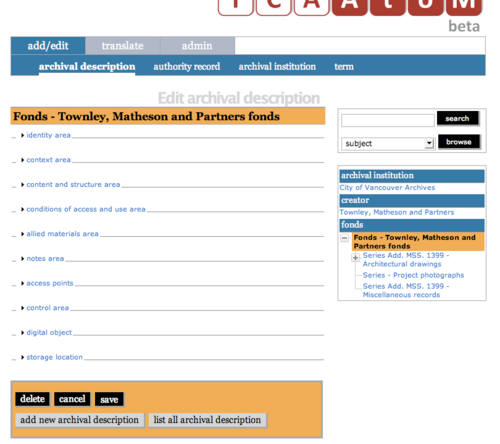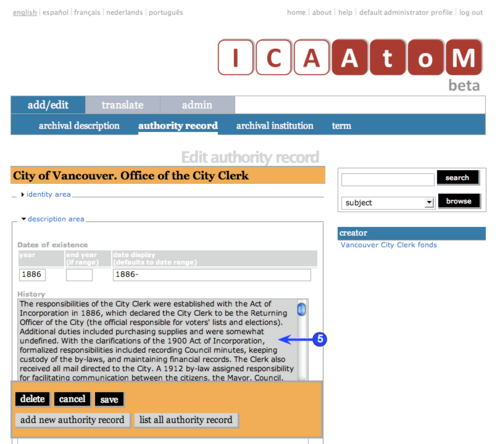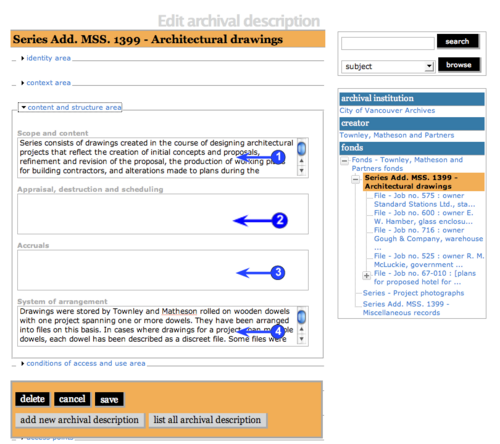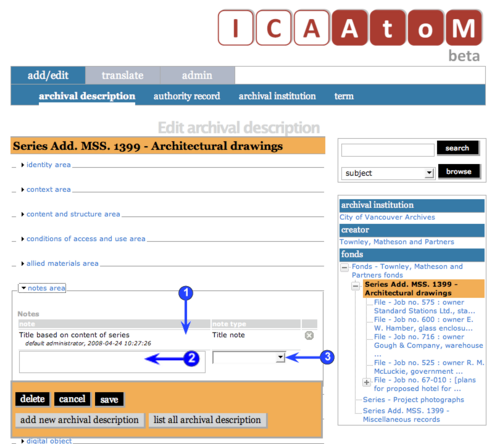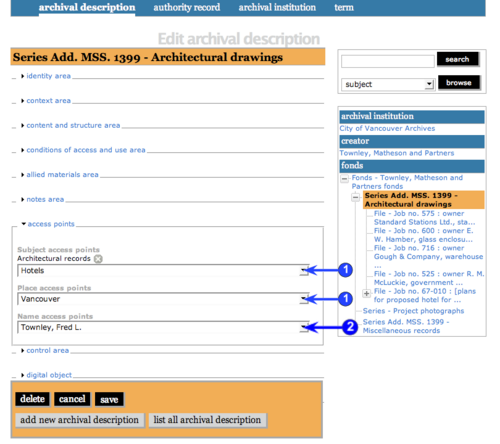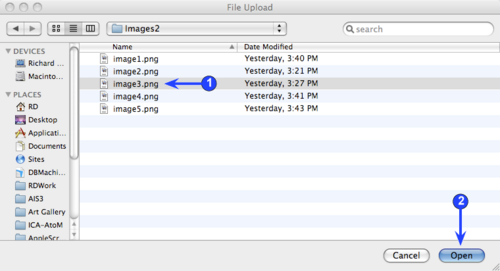Difference between revisions of "Add a new archival description"
| Line 329: | Line 329: | ||
== Digital object == | == Digital object == | ||
| − | [[Image:um3-1- | + | [[Image:um3-1-1Digital1.png|500px|right|thumb|Edit archival description: digital object area]] |
| + | |||
| + | [[Image:um3-1-1Digital2.png|500px|right|thumb|Select digital object for upload]] | ||
The ''Digital object area'' contains a field for uploading a digital file of the material under description (e.g. a digital photograph, scanned image, or born-digital electronic record). Typically this will be done at the '''item''' level. | The ''Digital object area'' contains a field for uploading a digital file of the material under description (e.g. a digital photograph, scanned image, or born-digital electronic record). Typically this will be done at the '''item''' level. | ||
Revision as of 16:55, 12 June 2008
Please note that ICA-AtoM is no longer actively supported by Artefactual Systems.
Visit https://www.accesstomemory.org for information about AtoM, the currently supported version.
Data entry: archival descriptions
Main Page > (UM) User manual > UM-3 Add / edit content > UM3.1 Add / edit archival descriptions > UM-3.1.1 Data entry: archival descriptions
The Edit screen for archival descripitons is structured into ten information areas. Seven of these are based on the "areas of description" in the ICA's General International Standard Archival Description (ISAD(G), 2nd edition, 2000).
- Identity area (↓)
- Context area (↓)
- Content and structure area (↓)
- Conditions of access and use area (↓)
- Allied materials area (↓)
- Notes area (↓)
- Control area (↓)
The other three represent additional functionality implemented in ICA-AtoM:
Click on a information area to expand it (display fields); click again to collapse it (hide fields). Note that as of the current version of ICA-AtoM (v1.0 beta), whenever you save a record ICA-AtoM re-loads the page, which collapses all areas.
The following notes aim primarily to clarify ICA-AtoM procedures; for guidelines on what information to record in particular fields, consult ISAD(G) as the content standard. The notes are organized by field, with links to the applicable ISAD(G) section(s). Where there is a one-to-one correspondence between an ISAD(G) element and an ICA-AtoM field, the note simply gives the ISAD(G) rule verbatim.
Identity area
The Identity area contains fields for conveying "essential information ... to identify the unit of description" (ISAD(G) I.11).
1. Reference code
- "Record, as necessary for unique identification, the following elements:
- the country code in accordance with the latest version of ISO 3166 Codes for the representation of names of countries;
- the repository code in accordance with the national repository code standard or other unique location identifier;
- a specific local reference code, control number, or other unique identifier.
All three elements must be present for the purpose of information exchange at the international level." (ISAD(G) 3.1.1)
2. Title
- "Provide either a formal title or a concise supplied title in accordance with the rules of multilevel description and national conventions.
- If appropriate, abridge a long formal title, but only if this can be done without loss of essential information.
- For supplied titles, at the higher level, include the name of the creator of the records. At lower levels one may include, for example, the name of the author of the document and a term indicating the form of the material comprising the unit of description and, where appropriate, a phrase reflecting function, activity, subject, location, or theme.
- Distinguish between formal and supplied titles according to national or language conventions." (ISAD(G) 3.1.2)
3. Title note
- Multi-value field for registering and displaying the notes relating to the title of the unit of description.
- Enter the note; when you click the Save button in the Button block the note will be registered and will now appear in the list above the data entry fields.
- There is no limit to the number of title notes you can add, but as of the current version of ICA-AtoM (v1.0 beta) you can only register them one at a time, i.e. enter the data, click the Save button, repeat for each additional contact.
- To delete a title note, click the Delete icon next to it in the list.
- Title notes also appear with other notes in the Notes area.
4. Level of description
- "Record the level of this unit of description." (ISAD(G) 3.1.4)
- ICA-AtoM ships with a default value list of levels; this can customized by editors and administrators.
5. Parent level:
- Select the unit immediately above the current one in the hierarchy of arrangement (parent record).
- Leave blank if the current unit represents the highest level of arrangement (e.g. a fonds).
6. Extent and medium
- "Record the extent of the unit of description by giving the number of physical or logical units in arabic numerals and the unit of measurement. Give the specific medium (media) of the unit of description.
- Alternatively, give the linear shelf space or cubic storage space of the unit of description. If the statement of extent for a unit of description is given in linear terms and additional information is desirable, add the additional information in parentheses." (ISAD(G) 3.1.5)
7. Note that the ISAD(G) Dates element (ISAD(G) 3.1.3) is implemented by ICA-AtoM in the Context area, where dates are linked to a creator in a creation event.
Context area
The Context area contains fields for conveying "information about the origin and custody of the unit of description" (ISAD(G) I.11).
Note that date ranges are handled in ICA-AtoM as creation events and recorded in this information area rather than the Identity area as per ISAD(G).
- At the highest level of description, the archival unit is associated with its creator over a certain date range.
- At lower levels, enter the date range, but leave the Creator name blank to inherit the creator from the higher level.
- If you want to associate a lower level with a creator different than the higher level, enter / select a different Creator name.
1. Creation context
- Multi-value field for registering and displaying creation events (dates of creation).
- Enter the event data (see steps 2-4 below); when you click the Save button in the Button block the event will be registered and will now appear in the list below the data entry fields.
- There is no limit to the number of other creation events you can add, but as of the current version of ICA-AtoM (v1.0 beta) you can only register them one at a time, i.e. enter the data, click the Save button, repeat for each additional event.
- To delete an event, click the Delete icon next to it in the list.
- For rules and examples relating to dates and creators, see (ISAD(G) 3.1.3 and 3.2.1).
2. Creator and Add new creator name:
- Select the creator's name from the Creator drop-down list (generated from the names of all existing authority records.
- If the creator's name does not appear in the list, use the Add new creator name field to enter the name.
- If you select a name from the drop-down list, ICA-AtoM will ignore any text you may have entered in the Add new creator name field.
- Note that you can leave both of these fields blank; in this case, the unit will inherit creator information from its parent record (next highest level of description).
- At the highest level of description, you should always include the creator; the Administrative history / biographical sketch is drawn from the creator's authority record.
- Lower levels inherit creator information from higher levels: use only if the creator is different at the lower and higher levels.
3. Creation year / End year
- Enter the opening and closing years of the date range.
- ICA-AtoM uses these values for sorting and searching purposes.
- Use only four-digit numbers.
- If the start and end years are the same, enter only in the Creation year and leave the End year blank.
- Complete at lower levels of description even if you are leaving the Creator name field blank (e.g. when describing a series, you do not need to repeat the Creator name from the fonds description, but you do need to enter the date range of the series).
- Do not use any qualifiers here (e.g. "ca.") or typographical symbols (e.g. "[194?]") to express uncertainty (see step4).
4. Date display
- Enter the date range as you want it to appear in view mode.
- Add any additional text to qualify date range (e.g. "ca. 1940-1980" or "[1940]-1980, predominant 1973-1980").
- Whereas Creation year and End year are used internally for database searching and sorting purposes, this field is for display purposes.
5. Administrative / biographical history
- Record concisely any significant information on the origin, progress, development and work of the organization (or organizations) or on the life and work of the individual (or individuals) responsible for the creation of the unit of description. If additional information is available in a published source, cite the source. The Information Areas of ISAAR(CPF) suggest specific informational elements that may be included in this element. For persons or families record information such as full names and titles, dates of birth and death, place of birth, successive places of domicile, activities, occupation or offices, original and any other names, significant accomplishments, and place of death." (ISAD(G) 3.2.2)
- If you have registered more than one creator in the creation events, the administrative histories / biographical sketches of each will appear here sequentially, separated by a line.
- This data actually resides in creator's authority record. It cannot be directly edited here; to edit, click the Edit icon; ICA-AtoM routes you to the related authority record in edit mode. Make changes and save; ICA-AtoM returns you to the Edit archival description screen and re-loads the page, collapsing all information areas.
6. Repository
- From the drop-down menu, select the archival institution that holds the archival material under description.
- The list in drop-down menu is generated from all existing archival institution records.
- If the repository does not appear in this list, you need to create it separately; see Add / edit archival institutions (UM-3-3).
- Typically you need only enter this information at the highest level of description (e.g. the fonds or collection; series in a series system); it can be left blank at the lower levels if they are all stored in the same repository.
7. Immediate source of acquisition
- "Record the source from which the unit of description was acquired and the date and/or method of acquisition if any or all of this information is not confidential. If the source is unknown, record that information. Optionally, add accession numbers or codes." (ISAD(G) 3.2.4)
8. Archival history
- "Record the successive transfers of ownership, responsibility and/or custody of the unit of description and indicate those actions, such as history of the arrangement, production of contemporary finding aids, re-use of the records for other purposes or software migrations, that have contributed to its present structure and arrangement. Give the dates of these actions, insofar as they can be ascertained. If the archival history is unknown, record that information. Optionally, when the unit of description is acquired directly from the creator, do not record an archival history but rather, record this information as the Immediate source of acquisition. (See 3.2.4)." (ISAD(G) 3.2.3)
Content and structure area
The Content and structure area contains fields that convey information "about the subject matter and arrangement of the unit of description" (ISAD(G) I.11).
1. Scope and content
- "Give a summary of the scope (such as, time periods, geography) and content, (such as documentary forms, subject matter, administrative processes) of the unit of description, appropriate to the level of description." (ISAD(G) 3.3.1)
2. Appraisal, destruction and scheduling information
- "Record appraisal, destruction and scheduling actions taken on or planned for the unit of description, especially if they may affect the interpretation of the material. Where appropriate, record the authority for the action." (ISAD(G) 3.3.2)
3. Accruals
- "Indicate if accruals are expected. Where appropriate, give an estimate of their quantity and frequency." (ISAD(G) 3.3.3)
4. System of arrangement
- "Specify the internal structure, order and/or the system of classification of the unit of description. Note how these have been treated by the archivist. For electronic records, record or reference information on system design. Alternatively, include any of this information in the Scope and Content element (3.3.1) according to national conventions." (ISAD(G) 3.3.4)
Conditions of access and use area
The Conditions of access and use area contains fields that convey information "about the availability of the unit of description" (ISAD(G) I.11).
1. Conditions governing access
- "Specify the law or legal status, contract, regulation or policy that affects access to the unit of description. Indicate the extent of the period of closure and the date at which the material will open when appropriate." (ISAD(G) 3.4.1)
2. Conditions governing reproduction
- "Give information about conditions, such as copyright, governing the reproduction of the unit of description after access has been provided. If the existence of such conditions is unknown, record this. If there are no conditions, no statement is necessary." (ISAD(G) 3.4.2)
3. Language of material and Script of material
- "Record the language(s) and/or script(s) of the materials comprising the unit of description. Note any distinctive alphabets, scripts, symbol systems or abbreviations employed. Optionally, also include the appropriate ISO codes for language(s) (ISO 639-1 and ISO 639-2: International Standards for Language Codes) or script(s), (ISO 15924: International Standard for Names of Scripts)." ISAD(G) 3.4.3)
- ICA-AtoM implements this ISAD(G) element as two separate multi-value fields, each with drop-down menus. The value lists are based on the ISO standards and cannot be edited.
- Select the language and script. When you click the Save button in the Button block, ICA-AtoM registers the values and displays them in the list above the data entry field.
- There is no limit to the number of languages or scripts you can add, but as of the current version of ICA-AtoM (v1.0 beta) you can only register them one at a time, i.e. select the values, click the Save button, repeat for each additional language or script.
- To record a narrative note relating to either field, use the Notes area (see below).
5. Physical characteristics
- "Indicate any important physical conditions, such as preservation requirements, that affect the use of the unit of description. Note any software and/or hardware required to access the unit of description." (ISAD(G) 3.4.3)
6. Finding aids
- "Give information about any finding aids that the repository or records creator may have that provide information relating to the context and contents of the unit of description. If appropriate, include information on where to obtain a copy." (ISAD(G) 3.4.5)
Allied materials area
The Allied materials area contains fields that convey information "about materials having an important relationship to the unit of description)" (ISAD(G) I.11).
1. Location of originals
- "If the original of the unit of description is available (either in the institution or elsewhere) record its location, together with any significant control numbers. If the originals no longer exist, or their location is unknown, give that information." (ISAD(G) 3.5.1)
2. Location of copies
- "If the copy of the unit of description is available (either in the institution or elsewhere) record its location, together with any significant control numbers." (ISAD(G) 3.5.2)
3. Related units of description
- "Record information about units of description in the same repository or elsewhere that are related by provenance or other association(s). Use appropriate introductory wording and explain the nature of the relationship . If the related unit of description is a finding aid, use the finding aids element of description (3.4.5) to make the reference to it." (ISAD(G) 3.5.3)
4. Publication note
- "Record a citation to, and/or information about a publication that is about or based on the use, study, or analysis of the unit of description. Include references to published facsimiles or transcriptions." (ISAD(G) 3.5.4).
- ICA-AtoM implements this ISAD(G) element as a multi-value field.
- Enter the note; when you click the Save button in the Button block the note will be registered and will now appear in a list above the data entry field.
- There is no limit to the number of publication notes you can add, but as of the current version of ICA-AtoM (v1.0 beta) you can only register them one at a time, i.e. enter the data, click the Save button, repeat for each additional note.
- To delete an publication note, click the Delete icon next to it in the list.
- Publication notes are also displayed in the Notes area (see below).
Notes area
The Notes area contains fields that convey "specialized information and information that cannot be accommodated in any of the other areas" (ISAD(G) I.11).
1. Notes
- "Record specialized or other important information not accommodated by any of the defined elements of description." (ISAD(G) 3.6.1)
- ICA-AtoM implements this ISAD(G) element as a multi-value field for registering and displaying notes. It will display Title notes that were registered in the Identity area and Publication notes that were registered in the Allied materials area.
- Enter note data (steps 2-3 below); when you click the Save button in the Button block the note will be registered and will now appear in the list above the data entry fields.
- There is no limit to the number of notes you can add, but as of the current version of ICA-AtoM (v1.0 beta) you can only register them one at a time, i.e. enter the data, click the Save button, repeat for each additional note.
- To delete note, click the Delete icon next to it in the list.
2. Note
- Enter the note text.
3. Note type
- Select the type from the drop-down menu. The value list is generated by the "Note type" taxonomy, which can be edited by administrators and editors.
Access points area
The Access points area links archival descriptions to terms drawn from controlled vocabularies as a means of facilitating acess and retrieval. The current version of ICA-AtoM (v1.0 beta) supports subject, place, and name access points.
- ICA-AtoM implements access points as multi-value fields.
- Select a term from one of the drop-down menus; when you save the record, the access point will be registered and will now appear in the list above the data entry fields.
- There is no limit to the number of access points you can add, but as of the current version of ICA-AtoM (v1.0 beta) you can only register them one at a time, i.e. enter the data, click the Save button, repeat for each additional access point.
- To delete an access point, click the Delete icon next to it in the list.
1. Subject and Place access points
- The values in the drop-down menus are drawn from the Subjects and Places taxonomies.
- Both taxonomies can be edited by administrators and editors on the List taxonomy terms screen.
- If the subject or place you want to use does not appear in the list, you (or your system administrator or editor) must first add it to the taxonomy.
- For more on editing terms and adding to taxonomies, see in this manual: Edit taxonomies (UM-3.5).
2. Name access points
- The values in the drop-down menu are drawn all existing authority records.
- If the name you want to use does not appear in the list, you must first create its authority record.
- For more on creating authority records, see in this manual: Add / edit authority records (UM-3.2).
Control area
The Control area contains fields for conveying information "on how, when and by whom the archival description was prepared" (ISAD(G) I.11).
This information area has been standardized in ICA-AtoM for archival descriptions, authority records, and archival institutions and is described on a separate page:
- See in this manual: Data entry: control area (UM-3.4).
Digital object
The Digital object area contains a field for uploading a digital file of the material under description (e.g. a digital photograph, scanned image, or born-digital electronic record). Typically this will be done at the item level.
- For more on digital objects, see in this manual: Import / export content > Upload digital objects (UM-6.1).
1. Click the Browse button to navigate to and select the digital object.
2. In the dialog box, click the Open button.
3. ICA-AtoM stores the file. It creates two additional objects: a thumbnail and a reference display copy (in case the original digital object is too large to display in the ICA-AtoM interface).
4. Click the Save button in the Button block. When you return to view mode, either the original or (if it is too large) the reference copy will be displayed in the Digital object field.
